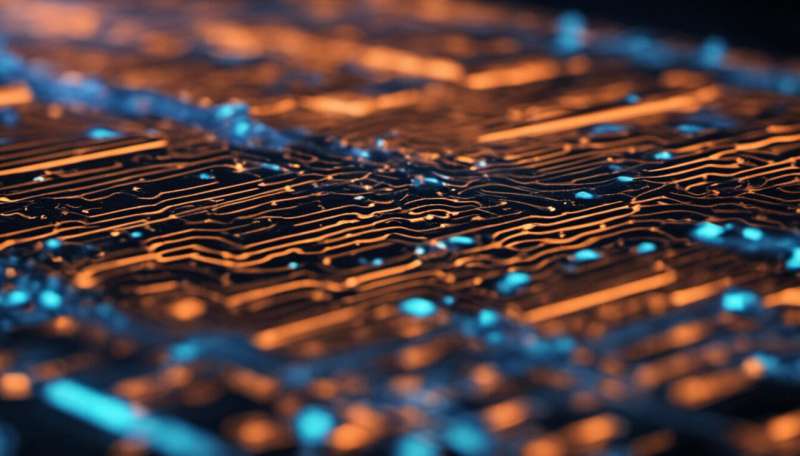Blockchain could be the key to securing nuclear material


Blockchain offers a strong system for tracking nuclear material where the digital record cannot be altered, but it must also provide confidentiality. Credit: Shutterstock
Did you know that many countries still rely on paper-based systems to keep track of transactions involving nuclear material?
Although not the case in Australia, the International Atomic Energy Agency (IAEA) is keen to improve nuclear safeguards that track all fissile nuclear material that could potentially enter undeclared weapons programs and be used to make bombs.
The IAEA reports to the United Nations and assists member states in the peaceful and safe use of nuclear power while preventing the proliferation of nuclear weapons.
Currently, each member state of the IAEA has its own regulator that must meet reporting requirements regarding nuclear material. This reporting provides evidence that a country’s nuclear activities are consistent with their stated intent, as well as helping the IAEA conduct inspections to verify this.
As more and more record keeping moves to electronic systems, driven by ongoing pressures for efficiency and fixed budget allocations in governments and at the IAEA, it becomes potentially easier to rewrite or modify previous records when the physical records are replaced.
This increases the need for auditability, combined with information security and efficiency. Continuous innovation in nuclear safeguards is essential to the mission of the IAEA, and the national regulators who contribute to its important work.
Therefore, the upcoming IAEA Symposium on International Safeguards, held every four years, will bring together regulatory authorities, governments, the research and development community and industry to identify challenges and opportunities under the rapidly evolving operating environment that we see today.
At the symposium in Vienna, Austria, we will present work suggesting that using blockchain technology to share an immutable ledger of nuclear material accounting information among all member states, as well as with the IAEA itself, could make falsifying electronic records in a diversion attempt significantly more difficult .
This proof-of-concept system, known as the Shared Ledger Implementation of Nuclear Material Accounting and Control (SLINMAC), provides a secure platform for sharing confidential reports, and an authoritative, auditable shared ledger of all transactions. SLINMAC is designed to complement established reporting practices and improve the efficiency of transit matching for both domestic and international shipments of nuclear material.
Security requirements for nuclear information
The IAEA Nuclear Information Security Implementation Guide states that: “Information security includes not only ensuring the confidentiality of information, but also includes ensuring the accuracy and completeness of the information (its integrity) and the availability or usability of the information upon request (its availability).”
A key benefit of blockchain technology is the excellent data integrity offered by cryptographically linking blocks together with self-referential hashes. Fraud of the ledger by editing a committed block breaks this chain and requires an impractical amount of computing power to rebuild with the fraudulent entries.
The decentralized nature of blockchain storage makes data instantly available and easily accessible. The blockchain is updated as soon as a transaction is accepted and multiple copies of the ledger are distributed among all nodes, building resilience into the network should it ever be compromised.
Although blockchain provides a strong system for tracking nuclear material where the digital record cannot be altered – a simple open blockchain does not offer confidentiality by default, as all parties can read the ledger hosted on their nodes.
This is a problem since certain information about nuclear security, or intellectual property used for clean energy or nuclear medicine, must be kept private for good reasons.
The solution is that information related to nuclear safety controls must be encrypted on the ledger, and during transport when it is uploaded and downloaded from the blockchain.
Not only that, but encryption used must guarantee long-term protection of data for the lifetime of the underlying asset, which can extend into timescales of thousands of years for nuclear waste management. In this context, the high integrity and accessibility of blockchain records really comes to the fore.
The key advance of SLINMAC is to investigate how end-to-end encryption, which is essential for the blockchain to meet nuclear security requirements, affects the auditability of the system. SLINMAC uses a multicast encryption protocol, which enables multiple organizations to decrypt the same information and also verify each other’s access. This is important when the same report is to be distributed between nuclear facilities, the Norwegian Supervisory Authority and the IAEA.
The idea of using blockchain to track nuclear material is at an early stage of research and we welcome the opportunity to discuss SLINMAC at the symposium, as well as the more general concepts. This work builds on the first blockchain demo of a security information system, called “SLUMBAT”, which we presented at the previous 2018 Safeguards Symposium, and which led to the SLAFKA project between UNSW, the Finnish national regular STUK, and the Stimson Center in 2020.
Increased global nuclear power is widely recognized by the IPCC as essential to achieving decarbonisation targets over the next 30 years and beyond. To accommodate the growing number of security transactions required for this to happen, the security community will need new technologies, such as blockchain, to scale efficiency, without compromising security and auditability.
We believe that technology like SLINMAC can increase confidence in the nuclear industry as a whole, while providing a new point of engagement for exciting technical collaboration between the nuclear security, blockchain and information security communities.
We want to ensure that nuclear power is produced in a safe way, and this partly depends on the information security associated with nuclear material, combined with transparency and auditability in the nuclear supply chain.
SLINMAC shows part of what this future could look like.
New NRL instrument improves ability to measure nuclear materials
Provided by the University of New South Wales
Citation: Blockchain May Be Key to Nuclear Material Security (2022, October 31) Retrieved October 31, 2022, from
This document is subject to copyright. Except for any fair dealing for the purpose of private study or research, no part may be reproduced without written permission. The content is provided for informational purposes only.
























